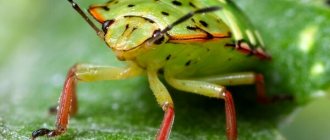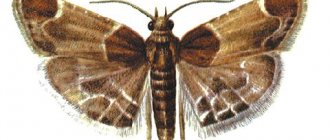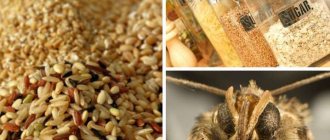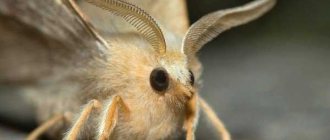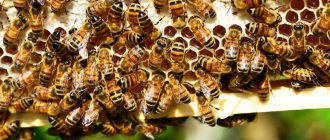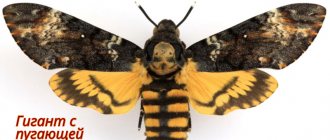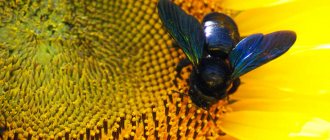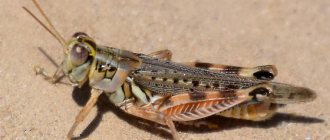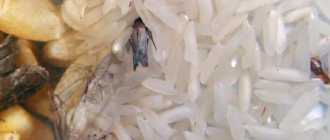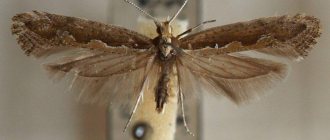- home
- Pest control
- Removing clothes moths in an apartment
- Types of moths
A moth is an insect that absorbs the substance of the stratum corneum - keratin. Such organisms are also called keratophages. But despite this, we often notice these insects crawling in the closet or flying around the house in search of woolen items. Why are they so attracted to wool? The answer is simple: at the molecular level, wool and fur contain the moth's favorite food product - keratin. Thanks to the unique environment of the stomach, which contains a lot of acid, moths easily digest keratin.
general characteristics
The moth belongs to the order of lepidopteran insects that develop their activity at dusk. Adults do not cause any harm. They just reproduce and lay eggs. They do not have a proboscis, since the oral mechanism is equipped with powerful jaws capable of crunching the bones of any plants and feeding on their seeds.
What does a mole look like:
- The pest is very similar in appearance to butterflies.
- But these winged colorful insects feed on the nectar of flowers, having a long proboscis. An adult moth is not even able to digest food. She only breeds offspring. She accumulates all her energy while in the state of a caterpillar.
Therefore, you should not waste energy fighting adult moths: moth larvae feed on things and furniture.
Appearance of a moth larva
Everyone can imagine a small fruit worm, which is often found in apples or other fruits that have not been treated with pesticides. This will allow you to understand what a moth larva looks like.
Appearance of a moth larva
The pest caterpillar is pale yellow in color, has 12 limbs and a darker head. The length can be from 6 to 12 mm. Thickness no more than 2 mm.
Fruit caterpillars and moth larvae are similar in appearance, so the presence of pests in the house is easier to notice by flying silvery moths.
Lifespan
Hardly anyone thought about how long a moth lives. She cannot be considered a long-liver. The total lifespan of a winged individual is from 2 to 4 weeks, depending on the type of moth. Insects move and fly little. The main activity occurs at dusk, as they are good prey for any predator.
To reach sexual maturity, the moth must go through certain stages of development:
- the female lays eggs twice a year, from which caterpillars appear two weeks later, the temperature is +20 degrees, which is favorable for the development of offspring;
- Moth larvae form a nutritious cocoon around themselves, where they develop for 3-10 months.
If we consider the full life cycle of an insect, then moth eggs go through a long stage of development to the state of an adult, all this time feeding on the materials and products in which they live.
How does it reproduce
To fight these insects, you need to know how moths reproduce .
This process includes steps such as:
- egg;
- a caterpillar that turns into a chrysalis;
- adult.
Only male moths fly. The female crawls around in search of a secluded place in which she lays eggs.
Moth caterpillars eat a wide variety of things and foods.
The rate of egg hatching directly depends on the ambient temperature:
- if it is less than 13°C, the ripening period is up to 37 days;
- at 33°C – 7 days.
Varieties
Types of moths
There are about 3,000 representatives of these insects, and only a few dozen of their varieties are pests. They don't differ much in size. The main differences are in color, habitat, body and wing configuration. The following types of moths are best known to man:
- household: clothing, food, furniture, fur coats, carpet, wool;
- in the wild: ermine, foxglove, chestnut;
- in agriculture: cabbage, potato, wax, fruit, grain.
Interesting!
In nature, the life of a moth depends on weather conditions and the time of year. The man offered her more comfortable living conditions: constant warmth and food in abundance. Therefore, everyone knows from their own experience in dealing with this scourge how moths multiply in human habitation. It reproduces all year round, and the caterpillars of these apartment lovers go through all stages of development faster than their counterparts living in natural conditions.
Moths can get into an apartment in a variety of ways. Food or potato representatives most often enter the home through food products that are stored in warehouses for a long time. They lay eggs directly in the packages. The wood pest enters through ventilation ducts.
Methods of disposal
If there are moths in your apartment, there are several ways to get rid of them:
- Special aerosol. This remedy will help if you find the place where it lives and treat it. After using the aerosol, you need to leave the house for several hours, and after returning, do a wet cleaning.
- Velcro or moth traps. They are hung in the kitchen or near cabinets, the moth sticks and dies. Often they are simple paper, with a sticky backing, and are attached to inconspicuous areas of the cabinet.
- Pills . They can be placed in areas where moths are likely to appear.
- Folk remedies . This includes various repellent compositions of herbs, washing with soap or vinegar.
- To combat agricultural moths, indoor treatments are carried out; infected grain is heated or frozen. The room must be disinfected and dried well.
What are the best anti-moth products?
ChemicalFolk
Vegetables in which moths have infested are also treated. You can use chemicals or traditional methods that last longer and are more effective.
Any moth does not like strong movements and temperature fluctuations. Therefore, temperature treatment helps at home. Moreover, it tolerates both frost and heat equally poorly.
Clothes moth
Clothes moth
It is a small straw-colored insect up to 9 mm in size. This pest cannot appear just like that. He gets into the house with things that are bought in the store. The larvae are already hiding in clothes or furniture. After getting into the apartment, they simply begin to develop intensively and expand their habitats, settling on other wardrobe items in the clothing closet. The larvae especially love products made from natural materials, wool, and fur.
In several other ways, clothes moths can appear in the house:
- through open vents and windows;
- ventilation communications;
- from neighboring apartments.
In order not to breed malicious tenants in your apartment, it is necessary to install nets on window openings and ventilation vents.
Important!
Clothes moths can destroy not only old, but also new clothes. Worn items and second-hand furniture are more attractive to this species, as they make the path to the food source easier.
To prevent clothes moths from infesting your home, you must carefully inspect all seams, fur items, and shoes purchased at retail outlets. How to get rid of clothes moths if flying butterflies do appear:
- It is necessary to spray the products with special aerosols, wash them in hot water or treat them with steam.
- You can take things out into the sun and fry them for several hours.
- After processing, store in special tightly closed duffel bags.
How to fight insects
It doesn’t matter which way the moth got into the apartment. It is necessary to begin fighting it immediately after identifying the first adults or larvae. The sooner you start doing this, the faster you will be able to get rid of the pest.
Chemicals
Previously, tablets made from a mixture of naphthalene and camphor were often used, but the danger is that their vapors in high concentrations are harmful to humans .
Now there are many safe means:
- "Antimol." Available in tablets. It is enough to put 3-4 pieces in the closet. The tablets are valid for 21-28 days, then they are thrown away. The product is used to repel, not kill, moths.
- "Dezmol" is a drug similar to the previous one. Available in tablets.
- "Molemore." Validity is up to 6 months, but no more than 2 records can be used in one room. The drug repels, but does not destroy, insects.
- “Suprozol” is a drug in the form of an aerosol. Spraying in places where moths accumulate helps to effectively destroy adults and larvae.
- “Supromit” is a liquid product used to treat furniture surfaces. Its validity period is several months.
- "Moskitol" is a product in the form of plates. They are laid out in places that they want to protect from the penetration of moths.
- "Raid Antimol" is a popular drug. Available in the form of plates, gel or spray. The method of use depends on the release form.
- "Raptor". When sprayed onto clothing, it leaves no traces on it and has a pleasant smell.
Antimol is a reliable means of killing moths.
Special sections effectively repel moths. They have a pleasant aroma and can be safely used even to protect children's things. Mount them at the top of the cabinet. 1 section is capable of protecting a space of up to 0.5 m³. At the same time, in a room with an area of up to 15 m³, no more than 2 pieces can be used. The section is valid for 4-6 months.
Destruction of larvae
To fight them you will have to make efforts, because... larvae hide in the most inaccessible places. Clothes moths are easier to remove than food moths. To do this, take things outside and shake them out well, then leave them in the sun, and if possible, wash them at 60°C. After this, they are treated with moth repellents, and the cabinets are also treated.
If food moths are detected, you must urgently get rid of all contaminated food products. Adults are destroyed using aerosols. The shelves on which the products are located are treated with liquid agents or sprays (they must be stored in sealed containers).
Using aerosols, moth larvae are destroyed.
What folk remedies exist
Many people are afraid of the toxicity of chemicals, so they prefer proven traditional methods.
It must be remembered that most of these products do not destroy moths, but simply repel them.
Commonly used folk remedies:
- Orange peel. Place it in places where moths can lay eggs. It repels adult insects. The peel should be changed at least once a month.
- Laundry soap. They put it in the closet and also wash furniture with it. The downside is that the smell gets absorbed into the clothes.
- Lavender, wild rosemary, tobacco, chamomile, fir. It is enough to change bouquets of these herbs once every six months.
- Fir or lavender oil. Place an open bottle in the closet or soak cotton wool in it.
- Geranium. It is enough to have 1 such plant in a room, and its smell will effectively repel pests. It is better to place the flower on the window so that insects cannot get into the house.
- Rosemary, garlic, cloves. They are placed in jars with cereals.
- Vinegar. They are used to treat the surfaces of bedside tables, cabinets, and storage rooms.
- Temperature. Moths are afraid of both heat and cold. Clothes should be washed at 60°C, exposed to the sun at a temperature of about 30°C, or exposed to frost – 10°C.
Folk remedies can help fight moths.
Wool moth
This species is quite widespread. It lives not only in apartments and warehouses, it can be found in mills and museums. The larvae eat dirty clothes and dust. Therefore, you can hear the name dust moth. The larva is not able to completely eat clothing, but spoiling it well is not a problem. The wings can have a span of up to 2 mm. The front ones are painted light brown, with a golden-pearl tint. The hind wings are distinguished by a beige color, and there is a fringe along their edges.
On a note!
This species is very prolific; the female is able to lay up to 90 eggs during her very short life.
Reasons for appearance
Of course, the question of where moths come from worries everyone who has encountered such a problem. There is no definite answer, but still the most likely reasons for encountering a pest in your own home are:
- Flew through the window. If a lone butterfly has just entered your home, destroy it immediately. The female will lay eggs, and then the troubles will only increase.
- Brought with things. Since this parasite finds food for itself in anything (cereals, dried fruits, fur coats, carpets, books, etc.), the probability of being delivered to a clean home with some things or products is very high.
- Brought on by the fur of a domestic animal. If your pet walks outside for a long time, moths can lay eggs unnoticed in its fur. Further in the house they fall on the carpet or furniture, and then the usual development cycle.
- The agricultural moth “destined” ends up in warehouses and storage facilities along with contaminated cereals and vegetables.
Furniture moth
This type of moth is light yellow in color with golden wings. The female lays up to 300 eggs within a half-month. The larvae begin to move actively only when they gain access to adequate nutrition. The moth lays its eggs in crevices of wood, under furniture upholstery, eating it. Every homeowner dreams of getting rid of moths in their apartment. Indoor moths are afraid of sunlight, so the larvae begin to hide in cocoons. Unfavorable conditions prevent caterpillars from developing and parasitizing.
Furniture moths are similar in appearance to a food pest; it is quite difficult to distinguish them. If you look at a photo of a moth, only a specialist can recognize whether this individual eats wool or cereals.
What do moth larvae eat?
The consequences of the life activity of the house moth larvae look like a mixture of gnawed fabric, fur or dry foods mixed with a dusty substance.
Wool, fur, clothing and furniture insects feed on natural or mixed fibers, including some types of synthetics. The fur moth is capable of laying a path along its route, which will look like a shorn strip.
Moth eats fur coat
A smaller variety of furniture parasites immediately selects upholstery areas with a large amount of material for laying eggs, so that the hatched individual is provided with food from the moment of birth and cannot die. A hole appears in the place where furniture moths live.
Feeding individuals destroy the structure of grains and cereals, turning them into dusty mush, held together by the biological material of caterpillars and eggs.
Moth eats cereal
food moth
Food moth
Larvae of this species prefer to feed on grocery products, so they will not touch wool or fur. They are omnivorous for foods that contain carbohydrates. The most popular characteristics for larvae are:
- flour;
- cereal;
- seeds;
- pasta;
- cookie;
- dried fruits;
- nuts;
- candies.
Their presence can be detected by molded lumps of cereal and cobwebs on the grains. If tunnels are made in pasta, then this is a sure sign of the presence of parasites. Food moth larvae can be found wherever there is free access to food.
Important!
Moth caterpillars can even cope with plastic bags, so it is better to store food in metal, glass or wooden packaging.
The reproduction and development of the larvae of this species is faster than that of the clothes one, since the food of food representatives of insects is more varied and nutritious. If you find larvae in food, you need to throw them away immediately and try to get rid of food moths in the kitchen as quickly as possible. If the contamination is small, then the grains can be sorted, the flour sifted and everything calcined in the oven at a temperature above +50 degrees.
Popular questions
When housewives purchase an expensive fur product, they may have various questions about fur moths.:
- How to detect moth eggs in a fur coat? It is almost impossible to detect them. Moth eggs are so small that they are difficult to see with the naked eye. They do not exceed 0.5 mm in length. They are usually white in color and oval in shape. Under favorable conditions, larvae appear within 7 days.
- What are the signs of a moth infestation? Since the larvae cut out grooves, folds or wrinkles appear on the product. The larvae also shear off the fur, which leads to the formation of bald patches. In addition, moths are actively fluttering around the room.
- Where else can you find fur moths? Its caterpillars can be found in horseradish, cayenne pepper, saffron, bay leaves, mustard seeds, orris, opium poppy fruits, almonds, and peanut husks. In addition, this parasite can damage stuffed animals, unique zoological objects, tobacco stocks, as well as raw sheep wool.
The appearance of fur moths is a big nuisance that can be avoided if you follow reasonable recommendations during storage. It is always easier to prevent the appearance of such insects in the closet than to later deal with the consequences of their vital activity.
Wax moth
This insect is a threat to beekeepers. When settling in hives, caterpillars eat honey, bee bread and bee larvae. If there are a lot of pests, they can damage the protective layer of the hives, which prevents the bees from freezing in the cold.
Interesting!
Man has learned to use moth caterpillars for his own purposes. Since fermentation in the moth's stomach produces a substance called wax moth extract, which can destroy pathogenic bacteria, people have begun to use it as a natural remedy to treat many diseases. The extract-based preparation is known as wax moth tincture.
What to do if a moth still eats a fur coat
When a moth has eaten a mink coat, the owner is not always able to save the product. This is influenced by the degree and area of the damaged area (which fragment of the fur coat was eaten by the moth). If there are too many “bald patches”, then you will have to say goodbye to the fur coat or you will need to change the style of the product, shorten the bottom or cut off the sleeves.
If a fur coat is eaten by moths, but the damage turns out to be insignificant, then the defect can be eliminated with the help of paint. The result depends on the correctly selected paint tone . Sometimes the bald spot is cut out and the edges are carefully sewn together from the inside. If the stain is on the chest or collar, then it can be covered with a brooch or scarf.
Potato and cabbage moth
These pests can destroy crops. Their difference lies not only in color, but also in the type of food that they prefer. Dirty gray moth, settling in potato tubers, damages the integrity of the fruit, and in the spring, during sowing, it again enters the soil.
The cabbage representative looks like a straw when its wings are folded. It flies poorly, but multiplies quickly, damaging the juicy young leaves of the vegetable. As a result of such proximity, the cabbage crop may die.
Why are moth larvae dangerous?
The greatest health hazard is foodborne pests. In a few weeks, they can settle in almost all grocery products and not only digest some of them, but also contaminate them with waste products.
The use of contaminated mixtures can lead to intoxication of the body.
The risk of illness when wearing things after clothing moths have lived in them without cleaning occurs primarily in people suffering from allergies. After using the fabric, the wearer's skin may become irritated.
How can you tell if there are moths in your house?
The eggs of the pest are very difficult to detect: their length is no more than half a centimeter, and their color is translucent. After a week, moth larvae are born from the eggs, which cause damage to the fur. They eat only the fur, leaving the skin behind. For this reason, bald spots appear. From them you can understand that the fur coat has new owners.
There are also indicators of damaged wool:
- the fur has lost its attractiveness, lumps have formed;
- “cut” fur appeared under the fur coat;
- folds have formed that were not there before;
- the presence of clipped paths;
- Adult moths move around the apartment.
If you notice one of these signs, you should take action immediately, otherwise the clothes will no longer be salvageable.
Fighting leafminer moths
It is not easy to defeat a harmful insect; in the larval and caterpillar stages it is little susceptible to poisons and chemicals. But you can fight with adult flying individuals. This way they will not have offspring and will not form new colonies.
- Carefully inspect and tear off all leaves with the slightest traces of punctures on the surface (oviposition).
Collected affected leaves must be destroyed by fire and should never be used for compost or other purposes.
Preventive examinations should be carried out systematically throughout the season, especially paying attention to the plants adjacent to the patient. It is easier to prevent the spread of miners than to exterminate them later.
- At the stage of emergence of butterflies from moth pupae, cover the plants with non-woven fabrics . This is an effective remedy for vegetable and melon crops and small shrubs.
- It is good to spray tree leaves with water from a hose. The procedure is carried out before flowering begins every day.
- Greenhouse premises should be treated with insecticidal preparations before seedlings are planted, which are also carefully inspected. For adult plants and seedlings, quarantine is required before planting in a permanent place for at least 10 days.
- Preparations containing pyrethrum are used as a chemical to control pests . Every 2-3 days the plant is sprayed, a total of 5-6 times. If the effectiveness is low, the treatment is repeated. The same product can be used to shed the soil (dilute in water). To prevent the appearance of moths, you need to periodically spray the plants with an infusion of chamomile.
The defeat of plants by leafminer moths is, of course, a very unpleasant situation, but do not rush to give up on your plantings. With due diligence and taking comprehensive measures, it is possible to defeat the harmful insect. For greater efficiency, it is advisable to unite with your neighbors in order to destroy existing colonies through massive measures and prevent them from spreading to neighboring areas.
